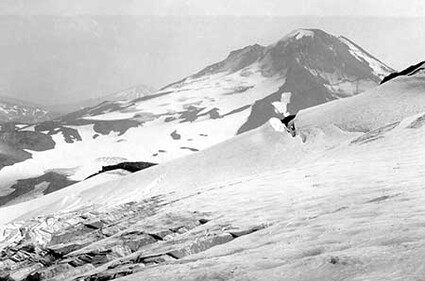Glaciers shrinking in Sisters Country
Last updated 5/24/2022 at Noon
The glaciers located in the Three Sisters area of the Cascade Range have become a physical statement on our current climate, according to Anders Eskil Carlson, PhD, president of the Oregon Glaciers Institute in Corvallis.
Carlson was one of the presenters during the Upper Deschutes Watershed Council’s Whychus Watershed Speaker Series this winter. His presentation dealt with the pending deglaciation of the Whychus Creek drainage, a subject of great importance to those who live in Sisters Country.
A simple definition of a glacier is a body of ice, at least 100 feet thick, that slowly flows under its own weight, formed from compacted snow accumulating over years. They form in areas where the summer temperature is at freezing.
In Oregon, there were 35 glaciers in the Cascades (13 in the Central Oregon Cascades) and one in the Wallowas (now gone). The smallest, southernmost glacier on Mt. Thielsen, Lathrop Glacier, has disappeared, after being in existence hundreds, maybe thousands of years.
According to Portland State University professor Andrew Fountain, “Fifteen percent of the glaciers in Oregon and Washington have disappeared since the 1950s and climate change is the dominating force in why that’s happened… by 2050 or 2060, Oregon will still have some glaciers but a lot of them will be gone.”
Carlson predicted Lathrop could return but with a huge proviso: if humans stop contributing to climate change.
“We could start cooling down again if we could reduce greenhouse gases in the atmosphere. With a cooler climate, the rain would turn to snow and the snow would stick around long enough to form a glacier. It’s not a done deal yet. We could go back, and the glaciers could regrow,” he said.
Here in Central Oregon, glaciers are on the decline. Broken Top had two glaciers that fed Tumalo Creek. One is now gone, and the other is not accumulating new snow. Carlson referred to it as “a glacier on hospice care.”
Of the 13 glaciers that have fed the Whychus Creek watershed, only five are left and they are likely to follow the others if nothing changes. Already dead are Linn, Thayer, Prouty, and Clark. Others are no longer accumulating snow or are shrinking.
“The ice cube is out of the freezer,” said Carlson.
Eighty-five percent of Oregon’s water use is irrigation, according to Carlson. The mountains hold our water. Losing the glaciers means the loss of our cold-water source, which directly negatively impacts stream habitat, which translates to fish habitat. Warmer streams mean warmer forests, which mean increased fire risk. Less storage of water in the glaciers means less surface water and in the aquifer, which means less water for everyone, including agriculture.
To explain what is happening, it is necessary to look at the changing climate. Most of the glaciers are no longer accumulating the snow year after year that is necessary to form the glacial ice. Since 2010, the +1.2 degrees C of global warming has moved the summer snowline in the mountains above the elevation of most of the glaciers. The summers are too warm, with the 2015 and 2021 heatwaves melting accumulated snow, removing any positive gains from prior cooler summers and/or snowier winters.
In 1980, the carbon dioxide levels were 350 parts per million. They are now at 412 ppm.
“Unless humans immediately cease to emit greenhouse gases and start to reduce the current level of carbon dioxide in the atmosphere towards a sustainable target below 350 ppm, glaciers will soon cease to exist in Oregon,” said Carlson.
In 1885, USGS geologist Joseph Diller, after whom one of the Three Sisters glaciers is named, said that Oregon’s Cascades were the most interesting field for glacial studies anywhere except Alaska.
Carlson pointed to a major problem being that we are in the 21st century, using 19th-century technology. He encouraged employing solar energy, which he claims would cover less land mass than the fossil fuel infrastructure.
“Despite the incontrovertible evidence of global warming and its impact on glaciers, as of 2021 the State of Oregon still shows no interest in documenting or understanding the retreat of Oregon glaciers and their attendant consequences to the environment and water resources of the state,” Carlson said.
The Oregon glacier maps currently in use are woefully out of date and not an accurate representation of the size or condition of the glaciers, according to Carlson.
For more information, visit www.orglaciersinsti.org.













Reader Comments(0)